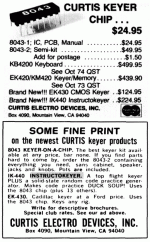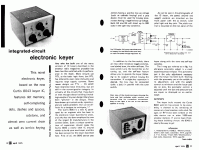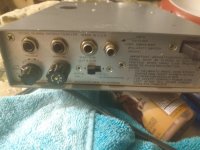Someone gave me this strange piece of equipment I've never seen nor heard of. Help me to figure out what it was used for, if it is still used for anything or will it just be a door stop or worse yet-end up in my scrap pile. It's a Instructokeyer IK-440A and it sits in a half rack little gray metal box with a few knobs on it (volume, pitch, weight and speed) and a few buttons(on power, tune, self test and code practice?) The rear panel has some 1/4 in. jacks(paddle, manual, side tone out 8 ohms) and a rca jack (xmtr keyline) and a selector switch (alpha only or full ) and one knob(lrt space std<>ext)
From what I gather it was used in ham radio, I'm not sure for what. So if you have some knowledge of this item please share...thanks!
From what I gather it was used in ham radio, I'm not sure for what. So if you have some knowledge of this item please share...thanks!
I don't know this particular model, but it sounds like a digital keyer for ham radio use. A typical CW (morse code) transmitter is keyed by closing a simple switch, the "key." Press down, the transmitter is on (keyed), release and the transmitter is off. The user is responsible for all the timing.
Mechanical "paddle" keys came next. Instead of a simple press or release knob there was a paddle with a weighted spring mechanism. Shift it from side to side to transmit dots or dashes and the timing was controlled by the mechanics of the mechanism.
With the advance of digital IC's came the digital keyer. The same left - right paddle system became two switches and the timing was controlled by the IC chips. The weight and speed knobs adjust the timing much like the adjustable weights on the old mechanical version. Some units produced a tone so the it could be used for code practice without a transmitter, hence the volume and pitch knobs. Some of todays radio equipment has the digital keyer function built in.
Back in the early 70's two guys in Minnesota designed a similar Digital Keyer. They sold kits and parts to build them. Their kit came and went, but they did pretty good at selling parts. We now call them Digi-Key.
I doubt the unit has much other use.
Note: I am a ham radio operator, but I have never used a digital keyer, so some of my explanation may not be 100% technically accurate.
Mechanical "paddle" keys came next. Instead of a simple press or release knob there was a paddle with a weighted spring mechanism. Shift it from side to side to transmit dots or dashes and the timing was controlled by the mechanics of the mechanism.
With the advance of digital IC's came the digital keyer. The same left - right paddle system became two switches and the timing was controlled by the IC chips. The weight and speed knobs adjust the timing much like the adjustable weights on the old mechanical version. Some units produced a tone so the it could be used for code practice without a transmitter, hence the volume and pitch knobs. Some of todays radio equipment has the digital keyer function built in.
Back in the early 70's two guys in Minnesota designed a similar Digital Keyer. They sold kits and parts to build them. Their kit came and went, but they did pretty good at selling parts. We now call them Digi-Key.
I doubt the unit has much other use.
Note: I am a ham radio operator, but I have never used a digital keyer, so some of my explanation may not be 100% technically accurate.
...this particular model.... digital keyer. ....timing was controlled by the IC chips...
The IK-440 advert from 1975, just after the Curtis Synth Chips guy produced the 8043 keyer chip. I guess "Instructo" in the name implies the code practice generator (not in the base 8043 chip, nor in the 8043-2 semi-kit in the HR article).
https://worldradiohistory.com/Archive-DX/Ham Radio/70s/Ham-Radio-197504.pdf
What is Iambic Keying? – OnAllBands
Attachments
Very good gentlemen. Curtis is the manufacturer of the device. I read briefly about it, but wasn't getting the gyst of it's limited simplicity. Ir is kinda like trying ro visualize pong after having an x-box. I used to be a CBer back in the 70's myself. I was 12 at the time



